Have you noticed Spring growth on your Citrus trees is coming through with a purple or red tinge?
Sometimes new growth and even young fruits will display quite a dramatic purple/red colour
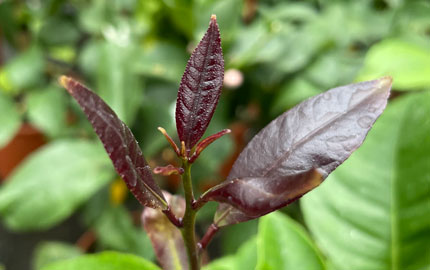
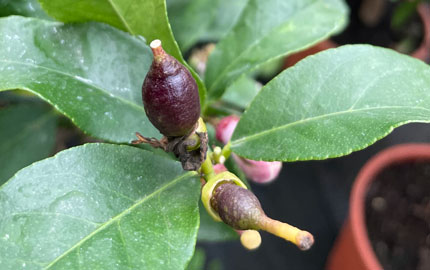
Lemon4seasons often develop these red purple leaves in Spring; and it can affect the young fruits and fruit buds too.
This Purple colour is a perfectly natural response to increased light levels.
Like many plants, citrus trees will sometimes respond to growing conditions by producing deep purple or red leaves and this colouring actually helps protect the young leaves from sun damage - almost like a natural sunscreen. Some plants like Photinia (Red Robin) are prized for this red Spring growth and in most cases over time the leaves will turn from red to a more glossy mature evergreen leaf. The same thing is true of citrus trees, under the right conditions most citrus varieties will display these red/purple new leaves but we find it's particularly noticeable in Lemon4seasons and Makrut limes. In our bright greenhouses in March and April is common for us to see new growth coming through with these dramatically coloured leaves but over time these will mature into dark green mature leaves.
This is nothing to worry about but it does tend to happen when the plant is putting on a lot of new growth and this means it's a good time to make sure you are keeping up with the feed. A balanced citrus feed should contain plenty of Nitrogen to ensure the new leaves come through green but also trace elements including iron, manganese, calcium and boron that help build the structure and framework of the leaf.
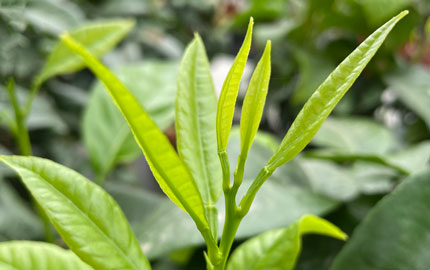
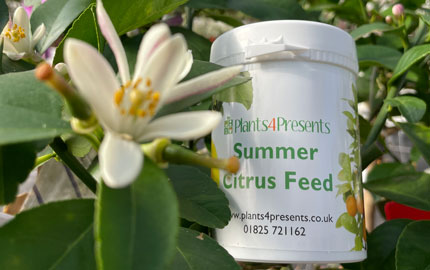
New leaves should mature to a rich dark green; putting on all this new season growth and blossom is hungry work so do keep up the feed!
All this Spring growth means your trees are hungrier than ever
At our nursery in Sussex we use a balanced Summer and Winter feed made up to our specific recipe and we switch from Winter to Summer feed once the days get longer. We have up to a thousand citrus trees on site at our Sussex nursery and we feed at least weekly throughout the growing season. When the trees are putting on particularly strong growth and there is a lot of this red purple growth coming through we will feed twice a week to ensure we are keeping up with our plants' needs. Citrus trees are particularly greedy plants and in a pot you will find your plants will do much better when you feed them regularly. If you've missed a few feeds for whatever reason, don't panic just re start feeding according to the instructions on the packet, we normally recommend feeding every other watering so when the weather is warm and your trees are putting on new growth that can often be a couple of times a week.
Not all feeds are created equal
We would obviously recommend our own citrus feed that we have developed and used at our nursery for the last 15 years and we can post it out to you with free delivery at any time. However there are other good feeds available and you should be able to pick up citrus feed at a good local garden centre. Just check it has lots of trace elements listed as well as Nitrogen, Potassium and Phosphorous and that there is a summer (high nitrogen) and winter (balanced NPK) version. We've seen customers get good results from lots of citrus feed brands but please avoid the Baby bio citrus feed.
As the new shoots develop keep an eye on the colour of the leaves
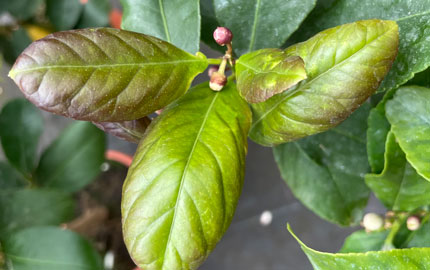
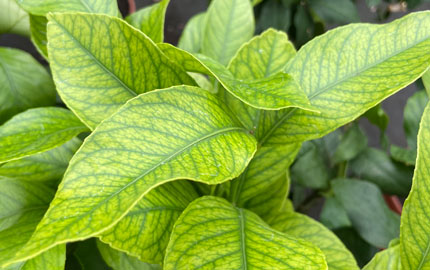
These leaves need a little more feed and particularly nitrogen to ensure they mature to a healthy dark green; the stripy markings on these leaves are a classic sign of Iron deficiency, if caught early enough this can be improved with an extra boost of nutrients.
Pale green, 'crinkled' looking or stripy markings on the leaves are all indications that the plant is not receiving enough nutrients but whilst these leaves are still developing you still have time to rectify the problem.
If your plant is in a small pot, now might be a good time to consider repotting to help get some extra nutrients to the roots. Use a pot just a pot size or two bigger than your existing pot and a good quality container or ericaceous compost (citrus compost is available but is not necessary and can be expensive). Another tip is to double the dose of any citrus feed for a couple of feeds to help boost nutrient levels. It's also worth using filtered tap water or rainwater with these feeds, as hard water can reduce the plant's ability to absorb nutrients. Unfortunately once the leaves have matured and developed a waxy feel you will no longer be able to regreen them. This means the key is to keep an eye on young growth and act quickly if the leaves are not coming through as they should. Pale leaves are usually an indication of nitrogen deficiency, whilst dark veins and a stripy pattern is an indication of iron chlorosis but a good feed should include all the nutrients your plant needs.
Don't forget, if you ever need any help or advice on your citrus plants you are very welcome to send us pictures through our main contact page and we'll be happy to take a look for you.
Still need help?
For more general tips on Spring citrus care don't miss our Top Tips video and full page all about positioning and watering citrus trees in spring
Don't forget to check out our full range of beautiful citrus trees for sale.

